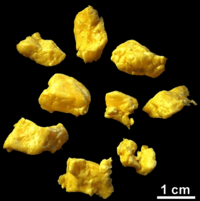- Cheese curds
-
- This article is about cheese curds as a regional delicacy. For general information about the dairy product, see curd. For information about the role of curds in cheese processing, see cheese.
Cheese curds in cuisine, or cooking, are the solid parts of soured milk either eaten alone or used in various regional dishes, mostly in Canada and the northeastern and midwestern United States. They are sometimes referred to as "squeaky cheese".[1][2]
Contents
Characteristics
Cheese curds are little known in locations without cheese factories because they should ideally be eaten within hours of manufacture. Their flavor is mild, with about the same firmness as cheese, but with a springy or rubbery texture. Fresh curds squeak against the teeth when bitten into, a defining characteristic, due to air trapped inside the porous material. This "squeak" has been described by the New York Times as sounding like "balloons trying to neck".[3] After 12 hours, even under refrigeration, they lose much of their "fresh" characteristic, particularly the "squeak".[4] Keeping them at room temperature can preserve the squeakiness.
The curds have a mild flavor and are sometimes somewhat salty. The American variety is usually yellow or orange, like most American Cheddar cheese, but doesn't require the artificial coloring. Other varieties, as in Quebec or New York State, may be naturally un-colored.
Uses
Fresh
Fresh cheese curds are often eaten as a snack, finger food or an appetizer. They may be served alone, dressed with an additional flavor, or with another food, such as a small smoked sausage or piece of cured pork, with the elements skewered together on a toothpick. Examples of flavorings applied to fresh curds include jalapeño chili peppers, garlic, various herbs, or spice blends such as so-called "Cajun seasoning", with garlic and dill on cheddar curds being a popular combination.[5]
Fried cheese curds
In the Midwestern United States, deep-fried cheese curds are often found at carnivals and fairs, and often local non-chain fast food restaurants and bars, as well as a few chain restaurants of local origin, such as Culver's. Deep-fried cheese curds are covered with a batter, like that used for onion rings, or are breaded and placed in a deep fryer.
In some areas, deep-fried cheese curds are also known as cheeseballs.[6]
Poutine
Main article: PoutineCheese curds are a main ingredient in poutine, a dish consisting of french fries topped with fresh cheese curds, covered with brown gravy and sometimes additional ingredients. The dish originated in rural Quebec, Canada, in the late 1950s. Several Québécois communities claim to be the birthplace of poutine, and one oft-cited tale credits Fernand Lachance as inventing the name. The sauce was allegedly added later, to keep the fries warm longer.
See also
- Leipäjuusto (Finnish squeaky cheese)
References
- ^ Heidi Knapp Rinella (2006-11-15). "Taste of the Town: Squeaky cheese curds spotted in valley". Las Vegas Review-Journal. http://www.reviewjournal.com/lvrj_home/2006/Nov-15-Wed-2006/living/10741147.html. Retrieved 2009-06-22.
- ^ Ryan List (2002-10-21). "Cheese squeaks in your mouth". Ludington Daily News. http://news.google.com/newspapers?id=jZIKAAAAIBAJ&sjid=DkwDAAAAIBAJ&pg=4876,5891395&dq=squeaky+cheese. Retrieved 2009-06-22.
- ^ Louisa Kamps, "Cheese Curds," NY Times, October 17, 2004
- ^ Tillamook Cheese Factory FAQs
- ^ [1]
- ^ Belleville, Kansas Dairy Queen website
American cheeses Alouette (cheese) • American cheese • Baby Swiss • Bergenost • Brick cheese • Buffalo mozzarella • Cheese curds • Colby cheese • Colby-Jack • Cream cheese • Creole cream cheese • Cuba cheese • D'Isigny (cheese) • Hoop cheese • Humboldt Fog • Kunik cheese • Liederkranz cheese • Maytag Blue cheese • Monterey Jack • Muenster (cheese) • Pepper jack cheese • Pinconning cheese • Red Hawk (cheese) • String cheese • Swiss cheese • Teleme cheese • Wisconsin cheese
Canadian cheeses Bleu Bénédictin • Bouq Émissaire • Cheese curds • Chèvre noir • Dragon's Breath Blue • Ermite • Friulano • Le Gré des Champs • Le douanier • Oka cheese • Pied-De-Vent • Le Riopelle de l'Isle • Sir Laurier d'ArthabaskaCategories:- American cheeses
- Canadian cheeses
- Cuisine of the Midwestern United States
- Canadian cuisine
- Quebec cuisine
Wikimedia Foundation. 2010.



